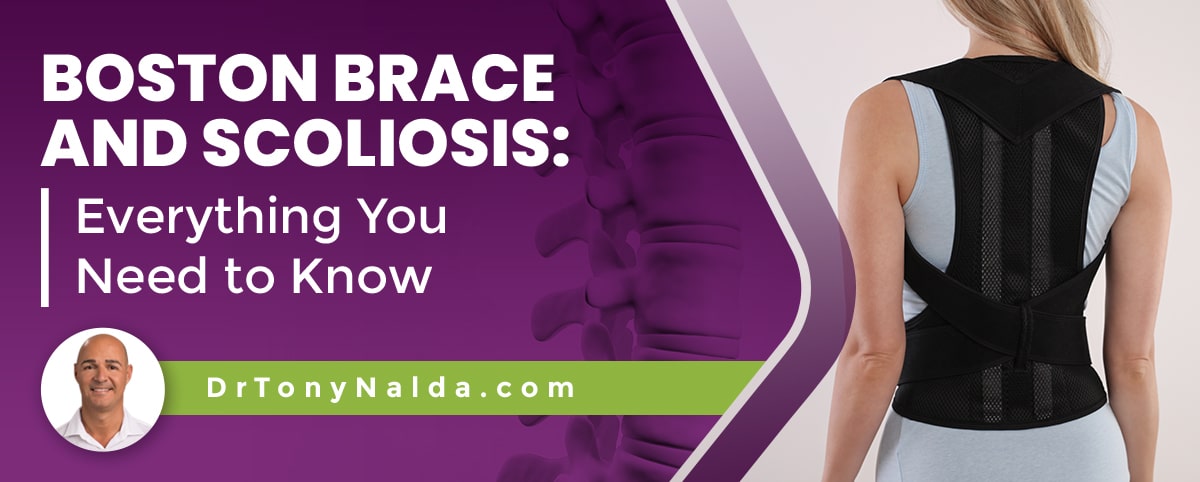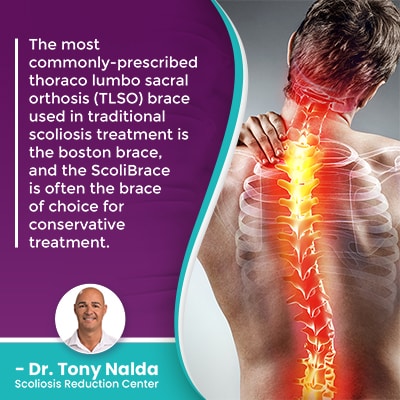Boston Brace and Scoliosis: Everything You Need to Know

Different treatment approaches offer scoliosis patients different potential outcomes, and not all scoliosis braces are created equal. The boston brace is the most commonly-prescribed brace based on traditional treatment, while the ScoliBrace is an ultra-corrective brace favored by a modern conservative treatment approach.
As a progressive spinal condition, the type of treatment a patient commits to is key, and the boston brace used in traditional scoliosis treatment is associated with a number of shortfalls; modern corrective bracing addresses many of the shortcomings associated with traditional scoliosis bracing.
Before bracing is applied, conditions need to be diagnosed, so let's start with the process of diagnosing scoliosis.
Table of Contents
Diagnosing and Classifying Scoliosis
Diagnosing scoliosis means an unnatural lateral curvature of the spine (side to side) that also twists (rotates) from back to front, front to back has developed.
It's the scoliotic spine's rotational forces that makes scoliosis a complex 3-dimensional condition, which is particularly important when it comes to bracing, and we'll expand on later.
In addition, a scoliotic curve also has to be of a minimum size to be considered a true scoliosis: minimum Cobb angle measurement of at least 10 degrees.
A patient's Cobb angle measurement is a key piece of information when it comes to diagnosing, assessing, and treating scoliosis as it determines condition severity.
The more out of alignment the spine is, the higher the Cobb angle, and the more severe the condition:
- Mild scoliosis: Cobb angle measurement of between 10 and 25 degrees
- Moderate scoliosis: Cobb angle measurement of between 25 and 40 degrees
- Severe scoliosis: Cobb angle measurement of 40+ degrees
- Very-severe scoliosis: Cobb angle measurement of 80+ degrees
Along with condition severity, conditions are classified based on patient age, curvature location, and condition type.
In addition, scoliosis is a progressive condition so has it in its nature to worsen over time, and as the lateral and rotational forces of the unnatural spinal curve increase, so does the scoliotic curve's size, and its effects.
When a patient receives a diagnosis of scoliosis, the most important decision to be made is how to treat it moving forward, and I want patients to be fully aware of all treatment options available to them, along with the potential effect of each.
In terms of long-term spinal health and function, the chosen treatment approach can have far-reaching effects.
Scoliosis Treatment: Traditional vs Conservative
 There are two main scoliosis treatment approaches: traditional and conservative.
There are two main scoliosis treatment approaches: traditional and conservative.
Traditional scoliosis treatment was the dominant choice for many years, but that doesn't mean it was the best, nor only treatment option available.
Traditional treatment involves spinal fusion surgery, and this can affect the spine in a number of ways; conservative treatment offers a non-surgical treatment response.
The end goal of traditional treatment is to stop progression, but the way it can achieve this, through fusing the curve's most-tilted vertebrae into one solid bone and attaching rods to the spine, is contrary to the spine's movement-based design.
The end goal of conservative treatment is to achieve corrective results, and this means correcting the scoliosis on a structural level; this is worked towards through an integrative treatment approach that combines multiple scoliosis-specific treatment disciplines so conditions are impacted on every level.
As these two scoliosis treatment approaches have different goals, it makes sense that they would favor a different type of scoliosis brace in treatment.
The most commonly-prescribed thoraco lumbo sacral orthosis (TLSO) brace used in traditional scoliosis treatment is the boston brace, and the ScoliBrace is often the brace of choice for conservative treatment.
The Boston Brace
Bracing is used as a facet of scoliosis treatment, particularly in young patients whose spines are still growing.
In traditional treatment, bracing is commonly applied for patients with moderate to severe scoliosis, but little is done, other than traditional bracing, to work towards preventing progression beforehand, which is why traditional treatment is commonly described as reactive, while conservative treatment offers a proactive response.
The boston brace has a number of shortfalls, mainly related to the fact that it ignores the rotational component of scoliosis, so its limited in its potential efficacy because it only addresses scoliosis as a 2-dimensional condition, when it's a complex 3-dimensional spinal condition.
The boston brace works towards stopping progression by squeezing the spine, through the application of intense pressure, but this type of unnatural squeezing and pressure is known to weaken the spine over time, and a scoliotic spine is already facing strength challenges.
In addition, the types of postural changes associated with scoliosis, particularly the development of a rig cage arch in the patient's torso, can be exacerbated by the boston because it's not addressing the spine's rotation.
The boston was designed in the 1970s, but its design has changed little since, despite our understanding of scoliosis and treatment efficacy changing over the years.
While some initial measurements are taken, the boston brace isn't fully customized to address a patient's condition and body type, making it uncomfortable and bulky to wear, and in many cases, the boston is prescribed as full time bracing, meaning worn up to 23 hours a day, for up to five years.
Considering the most-prevalent type of scoliosis, and the type that bracing is most effective on, adolescent idiopathic scoliosis, this age group is not known for their compliance, and adolescents also want to fit in with their peers, so wearing a bulky and uncomfortable brace full time isn't exactly aligned with that.
No brace has any chance of being effective if it's not being worn as prescribed, so compliance issues can be a barrier to brace efficacy.
Because of the squeezing nature of the boston brace, it's also associated with breathing problems, skin chafing, and activity restrictions, so boston braces can cause a number of side effects, and if a brace fits less than ideally, its discomfort is not going to be motivating to young patients.
Braces need to be fully customized to each individual patient so they can be as comfortable and discreet as possible, and this is where braces that use corrective forces tend to excel.
The ScoliBrace
 For those on the path of conservative treatment, the ultra-corrective ScoliBrace is the brace of choice because it represents the culmination of what we have learned about scoliosis, and brace efficacy, over the years.
For those on the path of conservative treatment, the ultra-corrective ScoliBrace is the brace of choice because it represents the culmination of what we have learned about scoliosis, and brace efficacy, over the years.
The ScoliBrace works by applying lateral forces in a more gentle manner than the boston; instead of squeezing the spine unnaturally, the ScoliBrace works by pushing the spine into a corrective position.
Each and every ScoliBrace is custom fitted based on a series of comprehensive images and measurements taken with state-of-the-art scanning technology and computer software.
Pushing the spine into an overcorrected position can complement other treatment disciplines that are part of a conservative approach such as physical therapy, chiropractic care, and rehabilitation.
The ScoliBrace is made to be easily closed and opened at the front, and the soft flexibility of the brace addresses compliance issues, and with different fabric-pattern choices, adolescents can further customize their braces to further encourage compliance.
Applying a hypercorrective force to a scoliotic spine, while other forms of treatment are being applied, can help achieve corrective results, and this means the condition has been impacted on a structural level in the form of a curvature reduction, and physical therapy and scoliosis-specific exercises have helped increase core strength so the spine's surrounding muscles can optimally support it, improve posture, and activate certain areas of the brain for enhanced brain-body communication.
Conclusion
What patients need to know about scoliosis treatment, and scoliosis bracing in particular, is that different approaches affect long-term spinal health and function differently, as do different braces.
The boston brace is a common tlso brace used in traditional scoliosis treatment, and because it doesn't address the condition's true 3-dimensional nature, it's limited in what it can achieve, and in addition, can actually harm the spine.
The boston works towards stopping progression by applying pressure to the spine, squeezing it unnaturally, and this is known to weaken the spine, increase posture deviation, and cause breathing problems.
In the years since the boston was designed, we have learned a lot about scoliosis and potential treatment efficacy, and in order for a scoliosis brace to be effective, it has to address the condition's true 3-dimensional nature by addressing the spine's rotation, and compliance also has to be in place.
The boston brace is used in traditional scoliosis treatment that funnels patients towards spinal fusion surgery: a procedure that can also negatively affect long-term spinal health and function.
There are many other scoliosis braces such as the providence brace, the charleston bending brace, the milwaukee brace, the wilmington brace, and the rigo cheneau brace, but the boston is the most common tlso brace used in traditional treatment.
The reality is that many scoliosis cases don't require surgery, and conservative treatment offers a non-surgical treatment alternative.
Here at the Scoliosis Reduction Center, I turn to the ScoliBrace to meet my patients' bracing needs because it offers corrective potential, and this is what preserves as much of the spine's natural strength and function as possible.
Dr. Tony Nalda
DOCTOR OF CHIROPRACTIC
After receiving an undergraduate degree in psychology and his Doctorate of Chiropractic from Life University, Dr. Nalda settled in Celebration, Florida and proceeded to build one of Central Florida’s most successful chiropractic clinics.
His experience with patients suffering from scoliosis, and the confusion and frustration they faced, led him to seek a specialty in scoliosis care. In 2006 he completed his Intensive Care Certification from CLEAR Institute, a leading scoliosis educational and certification center.
About Dr. Tony Nalda
 Ready to explore scoliosis treatment? Contact Us Now
Ready to explore scoliosis treatment? Contact Us Now





